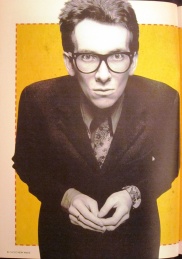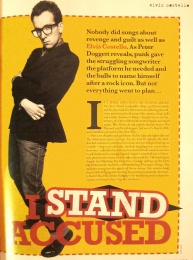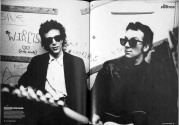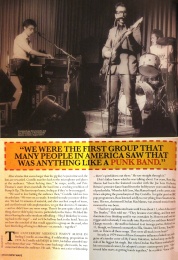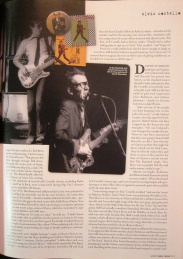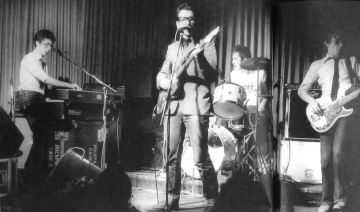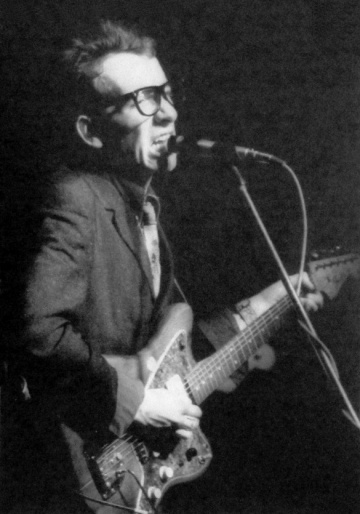|
It's three days since his second album, This Year's Model, reached the shops, and Elvis Costello and his new band The Attractions are following the well-worn promotional trail around the cinemas, bingo halls and seaside theatres of Britain. Tonight they're in Canterbury, the Odeon filled with student hippies and timid punks. The city has already played reluctant host to The Damned and Tom Robinson, but now it's March 1978, and Canterbury is ready for the New Wave.
After a set of earthy pub rock from Mickey Jupp, the lights dim and The Attractions arrive on stage. For the next 40 minutes the shell-shocked audience is subjected to a sonic and psychological barrage as Costello — bug-eyed, stick-like, his flesh dissolving into sweat before their eyes — unleashes his demons via a dozen vitriolic musical exercises in self-doubt and contempt. "Lipstick Vogue" is stretched into a Velvets-style attack on the senses, racked with tension and fire. The band segues sharply into "Watching The Detectives," Costello spitting out the lyrics like broken teeth. And then, without warning, he stomps off stage. The audience erupts into the ritual call for an encore. Five minutes later, they're still stamping and cheering, but growing increasingly uncertain. Is that it? Has Elvis left the building? Or is he sneering from behind the curtain, mocking his fans' dog-like obedience?
After a hiatus that seems longer than the gig they've just witnessed, the fans are rewarded. Costello marches back to the microphone and glares at the audience. "About fucking time," he snaps, acidly, and Pete Thomas's snare drum marshalls the band into a crushing rendition of "Pump It Up." The fans troops home, feeling as if they've been mugged.
"We used to love baiting the audience then," Costello told me two decades later. "We were on a crusade. It tended to make you more defensive. We had 35 minutes of material, and after our first couple of tours, and our first brush with amphetamines, we got that down to 25 minutes — and we didn't have any more songs. Then it became quite a knee-jerk thing, that we didn't play encores, particularly in the States. We liked the idea of leaving the radio simulcast still talking — 'Hey, I think they're coming back to the stage!' — and we'd be halfway back to the hotel. You can see how the mischief of that would appeal to a group on the road, who have this feeling of being in a lifeboat — or a trench — together."
The Canterbury audience wasn't alone in finding Costello an unsettling, if exhilarating, proposition in 1978. As Costello told Mojo in 2007, his father attended one of his shows that year: "When he came backstage afterwards, he was concerned about the audience. He said, 'This is not a nice relationship — there's spitefulness out there.' He saw straight through it."
Elvis's father knew what he was talking about. For years, Ross MacManus had been the featured vocalist with the Joe Loss Orchestra, Britain's premier dance band from the bobbysoxer years until the dawn of psychedelia. When he left Loss, MacManus forged a solo career, sometimes adopting the pseudonym of Day Costello. A regular guest on BBC pop programmes, Ross listened avidly to everything from Sinatra to Santana. His son, christened Declan MacManus, was around music from the moment he was born.
"I had very sophisticated taste until I was about 11, when I discovered The Beatles," Elvis told me. "They became everything, and beat music dominated my thinking until it was overtaken by Motown and soul and reggae and rocksteady. I was really into Marvin Gaye and those Return Of Django records — the stuff we listened to at teenage parties. Before I was 11, though, we listened constantly to Ella, Sinatra, Mel Torme, Tony Bennett, so I knew all those songs. They were all stuck in my head."
As early as 1979 traces of these formative influences leaked out, in the guise of a tender cover of "My Funny Valentine," tucked away on the flip-side of his biggest hit single. But when Declan MacManus embarked on his own musical career, he adopted a more contemporary pose. "I had several false starts at getting bands together," he recalled. "Some of the
|
